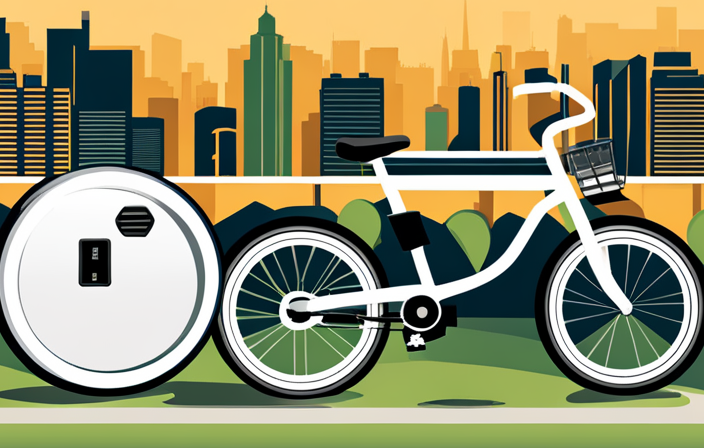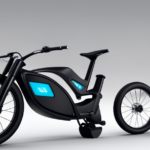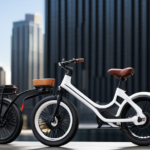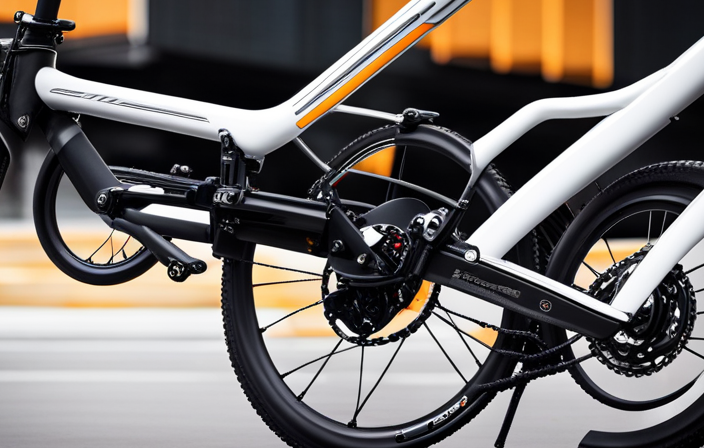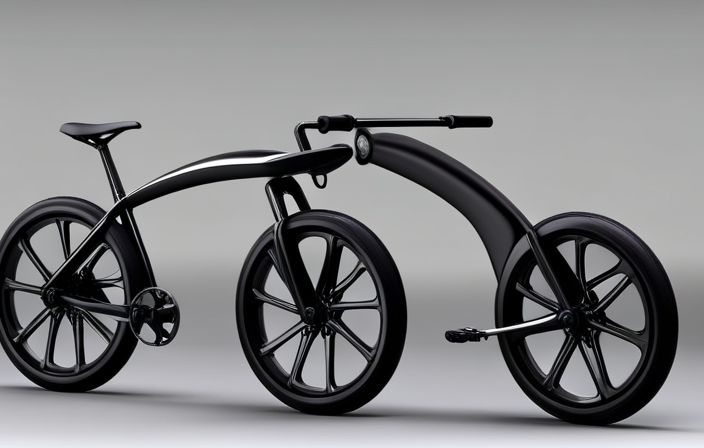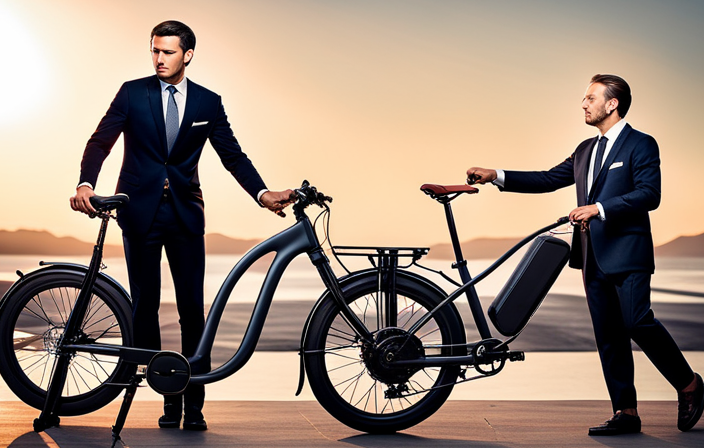Picture this: the wind in your hair, the thrill of the open road, and the freedom to go anywhere without breaking a sweat. That’s the beauty of electric bikes.
But with so many options out there, how do you know which one is right for you? In this article, I’ll guide you through the process of choosing the perfect electric bike for your needs.
From determining your riding style to considering battery capacity and additional features, you’ll have all the information you need to make an informed decision.
Let’s get started!
Key Takeaways
- Consider the terrain, distance, and riding style when choosing an electric bike.
- Set a budget and research the price range for different electric bike models.
- Understand the differences between hub motors and mid-drive motors and choose the right motor type for your needs.
- Evaluate power output, torque, noise level, and smoothness of motor operation to find the ideal electric bike for your specific requirements.
Determine Your Riding Style and Needs
To determine your riding style and needs, you should think about what type of terrain you will be riding on and how far you plan to travel. Choosing the right motor type is crucial in finding the perfect electric bike.
There are three main motor types to consider: hub-drive, mid-drive, and friction drive. Hub-drive motors are great for flat terrain and are generally more affordable. Mid-drive motors provide better balance and are ideal for hilly terrain. Friction drive motors are lightweight and easy to install, but they may not provide as much power as the other types.
Additionally, evaluating the availability of a display or control panel is important for monitoring your speed, distance, and battery life.
Once you have determined your riding style and motor type, it’s time to set a budget and find the perfect electric bike for you.
Set a Budget
When it comes to setting a budget for an electric bike, it is important to determine how much you’re willing to spend. Researching the price range for different electric bike models will help you make an informed decision.
Additionally, considering the long-term costs of maintenance and repairs is crucial to ensure that you are financially prepared for any unforeseen expenses.
Determine how much you are willing to spend
Consider how much you’re willing to spend before deciding on the type of electric bike to buy. Determining your preferred bike style and design is important, as it will affect the price range you should be looking at.
Some electric bike styles, such as mountain bikes or fat tire bikes, tend to be more expensive than others. Additionally, comparing the prices of different electric bike brands is crucial. Prices can vary significantly between brands, so it’s essential to do your research and find the best value for your budget.
Researching the price range for different electric bike models will give you a better understanding of what you can afford and what features you can expect within your price range.
Research the price range for different electric bike models
Researching the price range for various models of e-bikes will help you determine what features you can expect within your budget. When comparing electric bike prices, it’s important to consider several factors that can affect the cost. These factors include the brand reputation, battery capacity, motor power, and additional features such as suspension, gears, and display. To make your research easier, I have compiled a table with three rows and two columns that compares the price range of different electric bike models. This will give you an idea of the price range you can expect when shopping for an electric bike. Keep in mind that higher-priced models often offer better quality components and advanced features. Considering the long-term costs of maintenance and repairs is also crucial when making your decision. By understanding the price range and the factors affecting electric bike prices, you will be able to choose the right electric bike that fits your budget and needs.
Consider the long-term costs of maintenance and repairs
To make sure you’re aware of all the expenses involved, it’s important to factor in the long-term costs of maintaining and repairing your e-bike. Here are some key considerations when it comes to the long-term cost comparison and maintenance and repair of electric bikes:
-
Battery replacement: Electric bike batteries have a limited lifespan and will eventually need to be replaced. This can be a significant expense, so it’s important to factor this into your long-term cost calculations.
-
Regular servicing: Like any vehicle, electric bikes require regular servicing to keep them in optimal condition. This includes things like checking and adjusting brakes, gears, and tire pressure.
-
Repair costs: In the unfortunate event of an accident or component failure, repair costs can quickly add up. It’s worth considering whether the brand you choose has a good reputation for reliability and if replacement parts are readily available.
-
Warranty coverage: Be sure to check the warranty coverage for the electric bike you’re considering. A good warranty can provide peace of mind and save you money on repairs.
Considering these long-term cost factors will help you make an informed decision when choosing the right motor type for your electric bike.
Choose the Right Motor Type
When choosing the right motor type for an electric bike, it’s important to understand the differences between hub motors and mid-drive motors.
Hub motors are located in the wheel hub and provide a smooth and quiet ride. They offer a seamless integration with the bike’s design and are generally easier to install. However, they may not provide as much power output and torque as mid-drive motors.
On the other hand, mid-drive motors are positioned in the center of the bike, usually near the bottom bracket. This placement allows for better power output and torque, making them suitable for hilly terrains or off-road riding. They also provide a more balanced weight distribution and a more natural riding experience.
When evaluating the noise and smoothness of the motor’s operation, it’s crucial to ensure a comfortable riding experience. Some motors may produce more noise than others, and this can affect the overall enjoyment of the ride. Additionally, a smooth motor operation can contribute to a more comfortable and pleasant biking experience.
In conclusion, understanding the differences between hub motors and mid-drive motors, as well as evaluating the noise and smoothness of the motor’s operation, are important factors to consider when choosing the right motor type for an electric bike.
Understand the differences between hub motors and mid-drive motors
Understanding the differences between hub motors and mid-drive motors is crucial when deciding on the type of electric bike to buy. Both types have their own pros and cons, and it’s important to consider their performance comparison before making a decision.
In a hub motor, the motor is located in the hub of either the front or rear wheel. This design provides a simple and low-maintenance option, as there are no additional components involved. However, hub motors can add weight to the wheels, affecting the bike’s balance and handling. They also tend to have limited torque, which may limit their performance on steep hills or rough terrain.
On the other hand, mid-drive motors are positioned near the bike’s bottom bracket, directly driving the crankshaft. This central placement allows for better weight distribution and improved handling. Mid-drive motors also offer higher torque, making them more suitable for challenging terrains. However, they may require more maintenance due to their complex design.
Considering the power output and torque of the motor is another important factor when choosing an electric bike. By evaluating these aspects, you can ensure that the bike meets your specific needs and preferences. Transitioning into the next section about considering the power output and torque of the motor, it’s essential to analyze these factors in order to make an informed decision about the electric bike that best suits your requirements.
Consider the power output and torque of the motor
Considering the power output and torque of the motor is crucial in determining the ideal electric bike for your needs. The power output of the motor determines how fast the bike can go, while the torque determines how well it can climb hills or handle heavy loads. A higher power output means a faster bike, but it also means more power consumption and reduced power efficiency.
On the other hand, a motor with high torque can provide better performance in challenging terrains. Additionally, it’s important to consider the weight of the motor, as a heavier motor can affect the overall weight and maneuverability of the bike. Therefore, finding the right balance between power output, torque, and motor weight is essential for an optimal riding experience.
Evaluating the noise and smoothness of the motor’s operation will be discussed in the next section.
Evaluate the noise and smoothness of the motor’s operation
To determine the ideal electric bike for you, make sure to evaluate how smoothly and quietly the motor operates. When it comes to evaluating motor noise, pay attention to any unusual or excessive sounds that may indicate mechanical issues. A quiet motor ensures a peaceful and enjoyable ride, free from distracting noises. Additionally, assessing motor smoothness is crucial for a comfortable and efficient biking experience. A smooth motor operation means seamless acceleration and deceleration, allowing for a more controlled and pleasant ride. To make this evaluation easier, consider the following:
- Listen for any strange or loud noises coming from the motor.
- Observe how smoothly the motor transitions between different power levels.
- Pay attention to any vibrations or jerky movements during acceleration or deceleration.
- Test the motor’s responsiveness to changes in speed or terrain.
By carefully evaluating motor noise and smoothness, you can ensure a more enjoyable and efficient biking experience.
Moving on to the next section about battery capacity and range, it is important to consider…
Battery Capacity and Range
When choosing an electric bike, it’s important to note the battery capacity and range. The battery life and charging time are key factors to consider.
Battery life refers to how long the battery can power the bike before needing to be recharged. A higher capacity battery will provide a longer riding range, allowing you to go further on a single charge.
Charging time is also crucial, as it determines how quickly you can get back on the road after depleting the battery. Some electric bikes have fast-charging capabilities, enabling you to recharge the battery in a shorter amount of time.
These factors are essential to ensure that the electric bike meets your needs and can support your desired riding distance. Considering the battery capacity and range will help you make an informed decision when choosing your electric bike.
Now let’s delve into the next aspect, the frame and suspension.
Frame and Suspension
The frame and suspension of an electric bicycle are important factors to consider when making a purchasing decision. The frame determines the overall strength and stability of the bike, while the suspension affects the comfort and control while riding.
When it comes to the frame, it’s crucial to choose the right size and geometry that suits your body and riding style. A well-fitted frame ensures a comfortable riding position, reducing strain on your back and joints.
As for the suspension, there are two main types to choose from: front suspension and full suspension. Front suspension bikes have a suspension fork on the front wheel, while full suspension bikes have both front and rear suspension. The choice between the two depends on the type of terrain you’ll be riding on.
Now, let’s move on to the next important aspect: brakes and gears.
Brakes and Gears
Now that we’ve discussed the importance of choosing the right frame and suspension for your electric bike, let’s move on to another crucial aspect: brakes and gears.
When it comes to riding an electric bike, having reliable brakes is essential for your safety. Look for bikes with disc brakes, as they offer superior stopping power and are more effective in wet conditions.
As for gears, understanding gear shifting techniques is key to maximizing your riding experience. Electric bikes usually come with multiple gears, allowing you to adjust the level of assistance provided by the motor. Learning how and when to shift gears will help you maintain a steady pace and tackle different terrains effortlessly.
Now, let’s delve into the next section where we’ll explore additional features and accessories for your electric bike.
Additional Features and Accessories
When considering additional features and accessories for an electric bike, it’s important to assess the availability of fenders and racks for carrying cargo. These can be essential for practical purposes such as commuting or running errands.
Safety should also be a top priority, so it’s crucial to consider the presence of lights and reflectors.
Lastly, evaluating the availability of a display or control panel for monitoring battery life and assistance levels can be helpful in managing your ride and ensuring you have enough power for your journey.
Assess the availability of fenders and racks for carrying cargo
Assessing the availability of fenders and racks for carrying cargo can help determine the right type of electric bike to buy. When considering fender options, it’s important to look for bikes that come with built-in fenders or have the option to install them. Fenders are essential for keeping you clean and dry during wet weather rides.
In terms of cargo carrying solutions, having a bike with a sturdy rack can make transporting items much easier. Look for bikes that have a rear rack already installed or have the option to add one. Additionally, consider bikes with front racks or baskets for even more carrying capacity.
By assessing the availability of fenders and racks, you can ensure that your electric bike will meet your needs for both commuting and carrying cargo.
Speaking of safety, it’s also important to consider the presence of lights and reflectors for added visibility on the road.
Consider the presence of lights and reflectors for safety
Make sure to check if there are lights and reflectors on the electric bike you’re considering for added safety on the road. Lights and reflectors are crucial for enhancing visibility, especially during low-light conditions or at night. They help alert other road users to your presence and ensure that you can see and be seen in traffic. When evaluating an electric bike, it’s important to ensure that it comes equipped with front and rear lights, as well as reflectors on the wheels, pedals, and body. These safety features greatly reduce the risk of accidents and improve your overall riding experience. By investing in an electric bike with proper lights and reflectors, you can ride with confidence and peace of mind. Now, let’s move on to evaluating the availability of a display or control panel for monitoring battery life and assistance levels.
Evaluate the availability of a display or control panel for monitoring battery life and assistance levels
Check if the electric bike you’re considering has a display or control panel to monitor battery life and assistance levels. It’s important to evaluate the ease of use and readability of the display or control panel, as it will be your main source of information while riding.
Here are a few things to consider:
-
Look for a display or control panel that is intuitive and easy to navigate, allowing you to quickly access the information you need.
-
Compare the battery life of different electric bike models. Some displays may provide an estimate of how much battery life is remaining, helping you plan your rides accordingly.
-
Consider the assistance levels available on each bike. A good display or control panel will allow you to easily adjust the level of assistance to suit your needs.
By comparing these features, you can find an electric bike that offers the right balance of battery life and assistance levels for your riding preferences.
Once you have evaluated the display or control panel, it’s time to move on to the next step: test ride and research reviews.
Test Ride and Research Reviews
When figuring out what type of electric bike to buy, you should try taking a test ride and reading reviews to gather information.
Testing out different electric bikes will give you a firsthand experience of how they handle, the level of assistance provided, and the overall comfort. It’s important to pay attention to how the bike feels when you ride it, as this will greatly impact your enjoyment and usability.
Reading reviews can also provide valuable insights from other riders who have already purchased and used the electric bikes you are considering. They can give you an idea of the bike’s performance, durability, and any potential issues to be aware of.
By combining both a test ride and research, you can make a more informed decision about which electric bike is the best fit for your needs and preferences. As you consider after-sales support and warranty options, it’s important to keep in mind the information gathered from your test rides and research.
Consider After-Sales Support and Warranty
Don’t forget to consider the after-sales support and warranty options for your chosen electric bike. When making a significant investment like buying an electric bike, it’s essential to ensure that you have reliable after-sales support in case any issues arise. Additionally, a comprehensive warranty can provide peace of mind and protect you from unexpected expenses. To help you understand the importance of customer reviews and compare warranty policies, take a look at the table below:
| Electric Bike Model | Customer Reviews | Warranty Policy |
|---|---|---|
| Model A | 4.5/5 | 2 years |
| Model B | 4.2/5 | 1 year |
| Model C | 4.8/5 | 3 years |
| Model D | 4.3/5 | 2 years |
| Model E | 4.6/5 | 2 years |
By considering both customer reviews and warranty policies, you can make an informed decision about the electric bike that best suits your needs.
Make an Informed Decision
To make an informed decision, you’ll want to carefully consider all of the factors discussed and weigh them against your personal preferences.
When it comes to electric bikes, there are several cost-effective options available in the market. Look for bikes that offer good value for money and have positive customer reviews regarding their performance and durability.
Additionally, consider the environmental impact of your choice. Opting for an electric bike over a traditional one can greatly reduce your carbon footprint as they produce zero emissions.
You’ll also want to think about the overall cost savings in terms of fuel and maintenance. Electric bikes require less maintenance and can be a more affordable transportation option in the long run.
By taking these factors into account, you can make a well-informed decision that aligns with your budget and values.
Frequently Asked Questions
Are there any specific weight restrictions for electric bikes?
Yes, there are weight limits for electric bikes. It’s important to consider the weight capacity specified by the manufacturer. Additionally, battery life can be affected by the weight of the rider and any additional cargo.
Can electric bikes be used in all weather conditions?
Electric bikes can handle various weather conditions, making them versatile for year-round use. However, it’s important to note that extreme cold can affect battery performance. Regular maintenance, like cleaning and lubricating, can help ensure optimal electric bike performance.
What is the average lifespan of an electric bike?
The average lifespan of an electric bike can vary depending on several factors. These factors include battery quality, usage frequency, maintenance, and storage conditions. With proper care, an electric bike can last anywhere from 3 to 10 years.
Are there any legal requirements or regulations for riding an electric bike?
When riding an electric bike, it is important to follow safety precautions such as wearing a helmet and obeying traffic laws. Additionally, some areas may have insurance requirements for electric bike riders.
How long does it take to charge the battery of an electric bike?
Charging time for electric bike batteries varies depending on the model and battery capacity. For example, a high-end electric bike with a 500Wh battery may take around 4-5 hours to fully charge, providing a range of 50-70 miles. Battery life can also be influenced by factors like terrain and riding style.
Conclusion
After considering my riding style and needs, setting a budget, and researching different electric bike options, I have come to the conclusion that investing in an electric mountain bike is the best choice for me.
While some may argue that these bikes are more expensive and unnecessary for everyday use, I believe that the added power, durability, and off-road capabilities make it worth the investment.
With the right motor type, battery capacity, and additional features, I am confident that this electric bike will enhance my riding experience and provide long-lasting enjoyment.

